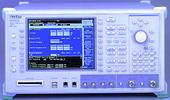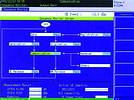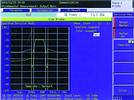
In October 2001, for the first time, commercial use of a next-generation mobile communications service enabling use of high-speed data communications via the Internet while on the move, began in the Tokyo metropolitan area under the name of FOMA. In December, the same service started in Nagoya and Osaka, and is now scheduled to begin in other major cities around the country.
FOMA is a third generation (3G) system employing the W-CDMA protocol. Globally, various 3G technologies including W-CDMA and CDMA2000 and 2.5G systems such as PDC Packet, CDMA2000 1x, GPRS and EDGE are being considered. Moreover, studies on 4G systems have already started.
Measurement solutions
Anritsu has supplied various measurement solutions for base stations and mobile terminals conforming to the next-generation W-CDMA system. Recently, Anritsu launched the MT8820A radio communication analyser, which can perform call processing and radio frequency (RF) characteristics testing of W-CDMA mobile terminals effectively using a single unit. Thanks to this, the MT8820A is useful in many fields from development and manufacturing to maintenance of W-CDMA mobile terminals. As such, it is ideal for mass production and maintenance for manufacturers.
The W-CDMA system, known as the 'next-generation mobile communications system' or the 'third generation' mobile communications system, is a radio access communications system that enables multimedia communications in which voice and high-speed data communications are integrated. In this system, the connection and performance of mobile terminals and base stations are all made to conform with the standards specified by the Third Generation Partnership Project (3GPP).
Naturally, it is difficult to carry out function and performance tests using base stations under actual communications conditions. Consequently, base station simulators capable of behaving the same as actual base stations are needed. The MT8820A has both basic performance as a base station simulator and radio frequency characteristics test functions. It was developed to satisfy such verification needs as: can a mobile terminal be connected to a base station for communications? Can voice and data be sent and received correctly after connection? And do the RF characteristics conform to 3GPP standards? Consequently, the MT8820As are indispensable on mobile terminal production lines (Figure 1).

The MT8820A
The basic performance and functions of three of Anritsu's measuring instruments, a signalling tester (for call processing tests), a digital mobile radio transmitter tester (for RF transmission tests) and a digital modulation signal generator (for RF reception tests) are integrated into the compact chassis of the MT8820A. By installing W-CDMA measuring hardware and software in the main frame, the MT8820A can perform high-speed RF transmission/reception and call processing tests on W-CDMA mobile terminals conforming to 3GPP standards under communication conditions using a single unit. The hardware platform covers a frequency range of 30 MHz to 2,7 GHz. In addition, it has a built-in GPIB interface that enables it to be integrated into automated production lines as well as be configured into an automated test system for after-sales maintenance.
MT8801 Series radio communication analysers, the predecessors of the MT8820A, have been highly evaluated at development and manufacturing sites for first- and second-generation mobile telephone equipment as instruments for performing RF transmission/reception tests on mobile terminals. The MT8820A, is now attracting the attention of communications instruments manufacturers the world over as the most advanced, most powerful instrument, capable of improving production line efficiency and product reliability.
Key features
* High-speed measurement for improved production line efficiency: The most advantageous feature of the MT8820A is its measuring speed. In the final test of a W-CDMA mobile terminal, nine transmission test items; maximum peak transmission power, frequency error, minimum transmission power, transmission off power, occupied frequency bandwidth, spectrum radiation mask, adjacent channel leakage power ratio, error vector magnitude and peak code domain error, need to be evaluated. The MT8820A can perform batch measurement of these in less than 0,2 of a second.
* Reception tests conforming to 3GPP standards: Since W-CDMA is distinguished not only by its high speed and large capacity, but also by the high quality of its voice communications, stringent tests are needed to evaluate signal quality. The MT8820A has two reception test functions. First, it can measure bit error rate under the test mode specified in the 3GPP standards (using the RF signal loopback method), and second, it can also measure bit error rate by directly inputting the demodulated data and clock signals to the MT8820A from mobile terminals under development.
* Call processing function, making connection tests of mobile terminals possible: Since the MT8820A has a call processing function for performing registration, origination, termination, disconnection from network, disconnection from terminal and hard hand-over tests, connection testing of mobile terminals is possible. The results of these tests are displayed on the sequence monitor screen as shown in Figure 2. Using this function also enables a simple voice communications test to be carried out by echoing back the voice signal from the terminal on the down-link signal.

* Increased throughput when installed on automated measurement lines: Together with expansion of WCDMA services, mass production of mobile terminals has been promoted and terminal designs and functions have become very diverse. Along with these, demand for lower measurement costs has grown. Easy operability and performance of measuring instruments installed on automated measurement lines greatly affects line efficiency. With the measurement results batch read command, the MT8820A can reduce the number of steps in the control program via GPIB. Selection of multiple measurement items, setting of the number of repetitive measurements, and one-touch batch measurement are also possible.
A large 21,3 cm high-definition, TFT LCD is adopted for the display to enable waveform display together with measurement results as shown in Figure 3. This enables visual recognition of phenomena, not only recognition by numerical data, when faults occur. In addition, use of a PC card allows the MT8820A to save and store measurement data and parameters.

Conclusion
Anritsu has been developing optimum solutions for the development, manufacture and maintenance of various digital mobile communications systems including PDC and PHS. In the future, development of new application software, fusion with 2.5 G system technology and development of 4 G system technology will become matters of concern in the field of mobile communications technologies. Anritsu provides total developmental solutions for the evaluation of W-CDMA systems using various advanced measuring instruments including the MT8820A. It will continue to supply total solutions in order to contribute to the W-CDMA testing needs of its customers.

© Technews Publishing (Pty) Ltd | All Rights Reserved